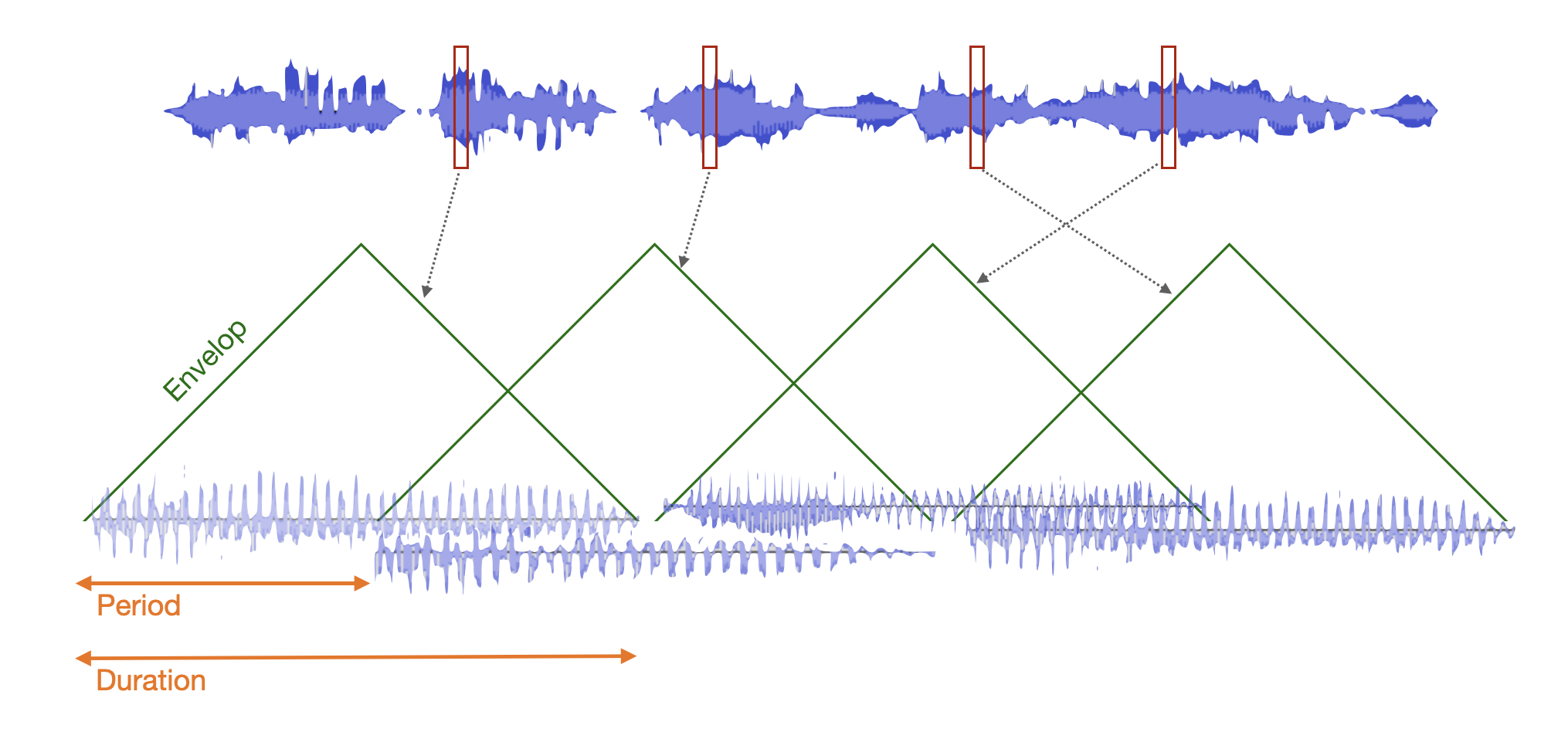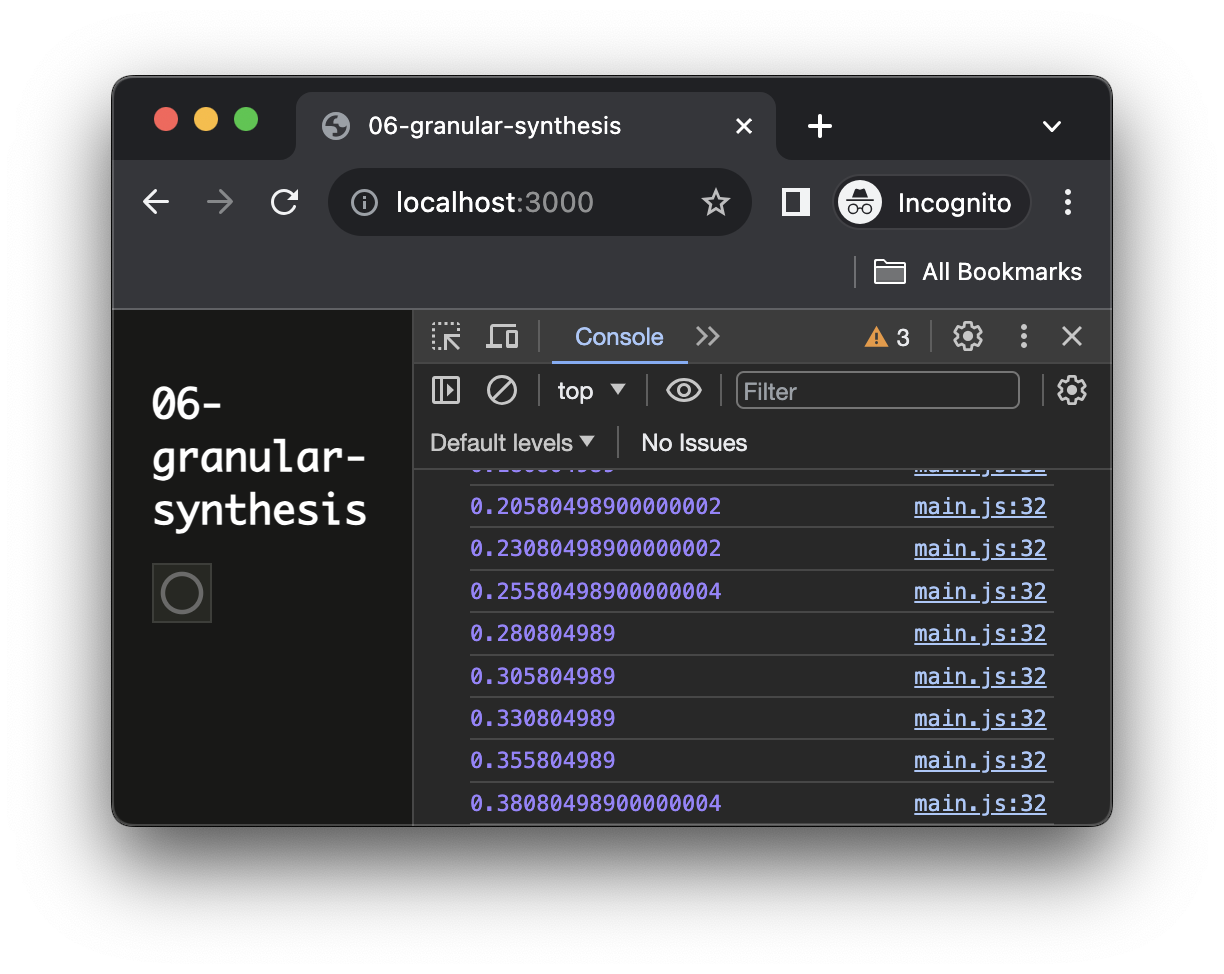Granular Synthesis
In this tutorial, you will learn how to implement a granular synthesizer using the Web Audio API leveraging on the lookahead scheduling technique we have seen in the previous tutorial.
Related Documentation
General principles
Granular synthesis is a sound synthesis technique that consists in cutting a audio files in small pieces of sound of around 5 to 200 ms called grains. These grains are then played back and layered to reconstruct a new sound. Each grain can also be manipulated independently by modifying for example their pitch, volume, etc.

Implement the synthesis engine
Scaffold the project
cd ~/Desktop/webaudio-tutorials
npx @ircam/create@latest 06-granular-synthesis --template=nobuild
cd 06-granular-synthesis
npx serveImport a library for scheduling
First, let's just import a library that will provide us with a much more robust version of the scheduler we implemented in last tutorial, while being build on the same principles:
// ./main.js
import { html, render } from 'https://unpkg.com/lit-html';
import { Scheduler } from 'https://unpkg.com/@ircam/sc-scheduling@0.1.6';
import 'https://unpkg.com/@ircam/sc-components@latest';Replace the default sample in ./assets/sample.wav with another longer one, and eventually modify the loadAudioBuffer first argument to match you file name:
// ./main.js
const buffer = await loadAudioBuffer('./assets/sample.wav', audioContext.sampleRate);
const buffer = await loadAudioBuffer('./assets/hendrix.wav', audioContext.sampleRate); INFO
The sample used in the tutorial can be downloaded here
Implement the audio engine
Let's start with defining the new class which will be our granular engine:
const buffer = await loadAudioBuffer('./assets/sample.wav', audioContext.sampleRate);
class GranularSynth {
constructor(audioContext, buffer) {
this.audioContext = audioContext;
this.buffer = buffer;
// time interval between each grain
this.period = 0.025;
// duration of each grain
this.duration = 0.1;
// position of the grain in the buffer
this.position = 0;
// create an output gain on wich will connect all our grains
this.output = this.audioContext.createGain();
}
render = (currentTime) => {
console.log(currentTime);
// ask to be called at time of next grain
return currentTime + this.period;
}
}For now, this doesn't make any sound, but let's see how to make it work with the scheduler:
// ./main.js
class GranularSynth {
// ...
}
// create a new scheduler, in the audioContext timeline
const scheduler = new Scheduler(() => audioContext.currentTime);
// create out granular synth and connect it to audio destination
const granular = new GranularSynth(audioContext, buffer);
granular.output.connect(audioContext.destination);
// register the synth into the scheduler and start it now
scheduler.add(granular.render, audioContext.currentTime);If you reload the page and open the console, you should see the start time of the grains logged into the console:

Let's then continue with implementing our render method:
// ./main.js
class GranularSynth {
constructor(audioContext, buffer) {
// ...
}
render = (currentTime) => {
// create our evenvelop gain
const env = this.audioContext.createGain();
// connect it to output
env.connect(this.output);
// schedule the fadein and fadeout
env.gain.value = 0;
env.gain.setValueAtTime(0, currentTime);
env.gain.linearRampToValueAtTime(1, currentTime + this.duration / 2);
env.gain.linearRampToValueAtTime(0, currentTime + this.duration);
// create the source that will play our grain
const src = this.audioContext.createBufferSource();
src.buffer = buffer;
// connect to output
src.connect(env);
// play the grain at given position and for given duration
src.start(currentTime, this.position);
src.stop(currentTime + this.duration);
// increment position so that we read the file at speed divided by 4
this.position += this.period / 4;
// make sure we don't try to pick a grain outside the buffer
if (this.position > this.buffer.duration - this.duration) {
this.position = 0;
}
// ask to be called at time of next grain
return currentTime + this.period;
}
}The code is finally quite simple as we just create an audio buffer source node, pipe it into gain with a simple envelop automation, which is itself connected to the output node of the synth. At the end of the render method, we just update the position of the next grain so that the source file is played back at a portion of its normal speed.
When you reload the page you should now hear your GranularSynth in action!
Adding controls
Let's now finalize our application to add control interfaces to change the parameters of the synthesis in real-time.
// ./main.js
render(html`
<h1>06-granular-synthesis</h1>
<div>
<sc-text>Period</sc-text>
<sc-slider
min="0.005"
max="0.1"
value=${granular.period}
@input=${e => granular.period = e.detail.value}
number-box
></sc-slider>
</div>
<div>
<sc-text>Duration</sc-text>
<sc-slider
min="0.01"
max="0.5"
value=${granular.duration}
@input=${e => granular.duration = e.detail.value}
number-box
></sc-slider>
</div>
<div>
<sc-text>Position</sc-text>
<sc-slider
min="0"
max=${buffer.duration}
value=${granular.position}
@input=${e => granular.position = e.detail.value}
number-box
></sc-slider>
</div>
`, document.body);And change our synth so that the position is not updated automatically but only controlled by the slider:
// ./main.js
class GranularSynth {
constructor(audioContext, buffer) {
// ...
}
render = (currentTime) => {
// ...
// increment position so that we read the file at speed divided by 4
this.position += this.period / 4;
// make sure we don't try to pick a grain outside the buffer
if (this.position > this.buffer.duration - this.duration) {
this.position = 0;
}
// ask to be called at time of next grain
return currentTime + this.period;
}
}If you play a bit with the controls, you can ear that with very low period values, the resulting synthesis produces pitched audible artifacts, which might not be desirable. This is due to the fact these values are so small that they start to be audible on their own, e.g. a period of 0.005 ms corresponds to 200 Hz.
A way to remove these artifacts is to add some jitter, or noise on the scheduling of the grain:
// ./main.js
class GranularSynth {
constructor(audioContext, buffer) {
// ...
}
render(currentTime) {
const jitter = Math.random() * 0.002;
const grainTime = currentTime + jitter;
// create our evenvelop gain
const env = this.audioContext.createGain();
// connect it to output
env.connect(this.output);
// schedule the fadein and fadeout
env.gain.value = 0;
env.gain.setValueAtTime(0, currentTime);
env.gain.setValueAtTime(0, grainTime);
env.gain.linearRampToValueAtTime(1, currentTime + this.duration / 2);
env.gain.linearRampToValueAtTime(1, grainTime + this.duration / 2);
env.gain.linearRampToValueAtTime(0, currentTime + this.duration);
env.gain.linearRampToValueAtTime(0, grainTime + this.duration);
// create the source that will play our grain
const src = this.audioContext.createBufferSource();
src.buffer = buffer;
// connect to output
src.connect(env);
// play the grain at given position and for given duration
src.start(currentTime, this.position);
src.start(grainTime, this.position);
src.stop(currentTime + this.duration);
src.stop(grainTime + this.duration);
// ask to be called at time of next grain
return currentTime + this.period;
}
}Congrats! Your granular synthesizer is now fully working
Going further
To improve the application, you could for example add some controls over:
- The pitch of each grain, using the
AudioBufferSourceNode.playbackRaterate param - Allow users to use their own audio file, by providing a way to drag and drop it directly into the interface, cf.
<sc-dragndrop>
Conclusion
In this tutorial, you have learned how to leverage on the scheduling technique we have seen in the previous tutorial to build your own granular synthesizer.
In the next tutorial, we will continue with the exploration of the scheduling by implementing a simple step sequencer.